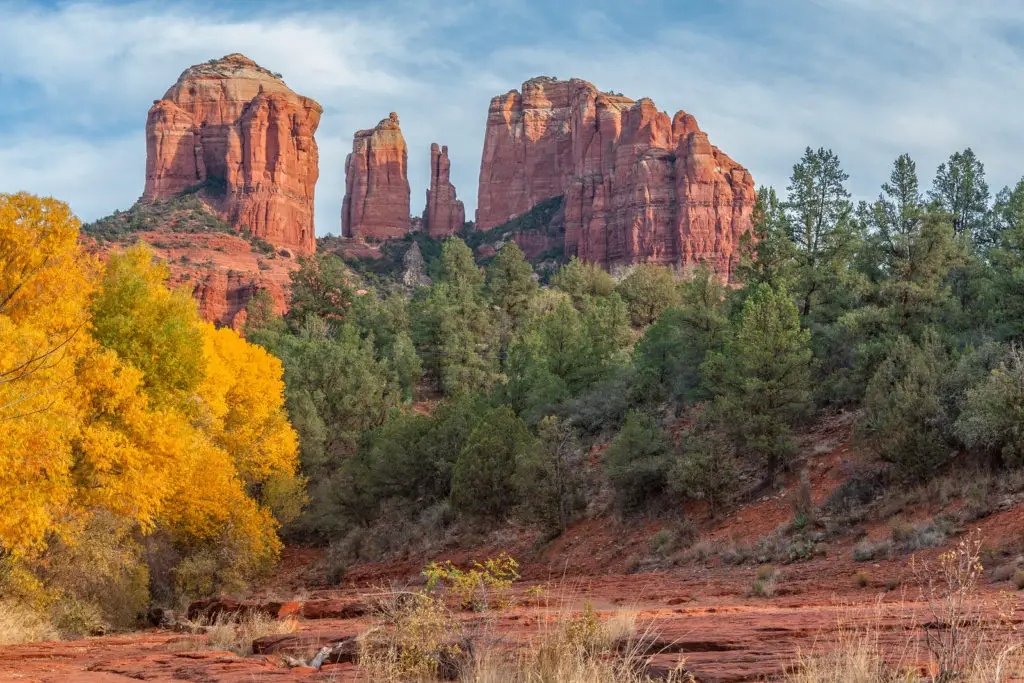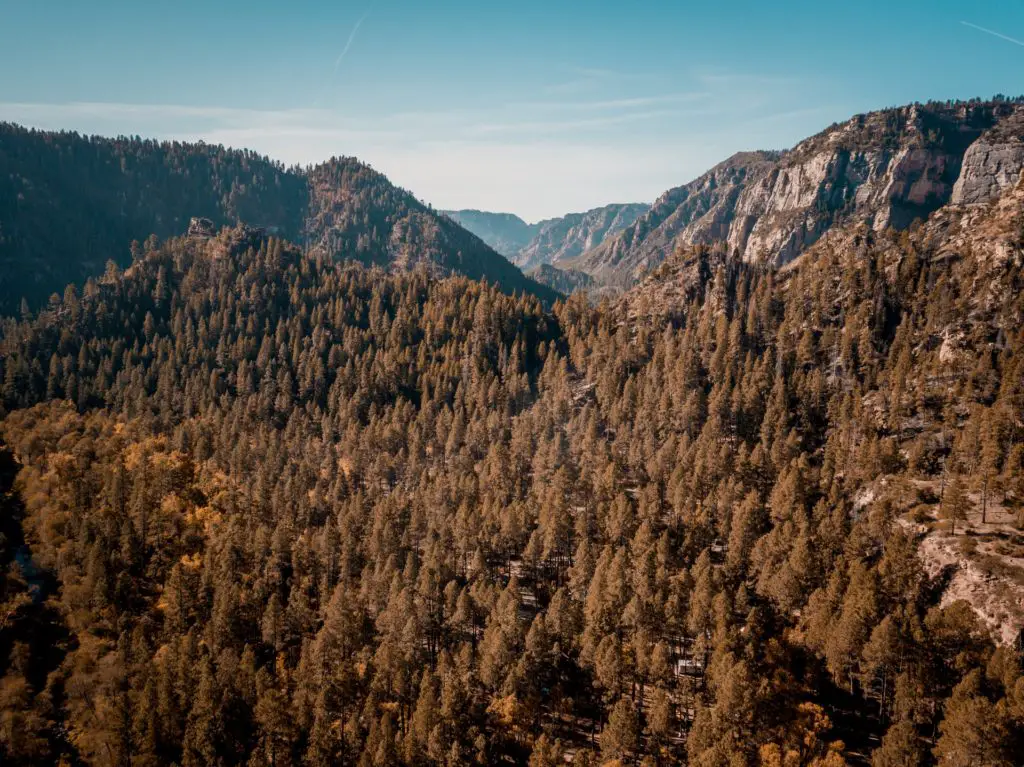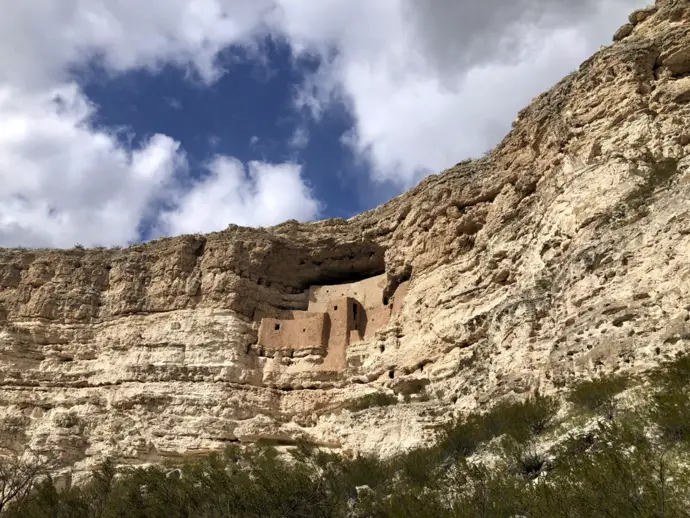Sandwiched between Flagstaff and Phoenix is Sedona, Arizona, a small desert town praised for its beautiful scenery, vibrant culture, and access to the gorgeous Red Rocks State Park. Once settled in by Native Americans, Sedona is rich in culture drawing in visitors from all across the country.
Sedona has become a top destination for all different kinds of tourists ranging from the outdoorsy to the art-deco to those wanting zen. While visitors often visit Sedona on a day trip from Flagstaff or Phoenix, the town has much to offer that can easily fill a longer stay.
Continue reading to find out which activities made our list of the top 13 things to do in Sedona, Arizona.
Hike Devil’s Bridge
This stunning bridge forms the top of a natural sandstone arch and is only a 1.8-mile hike, at the trailhead making it a great choice for beginners or families with small children. The trailhead itself starts at an impressive 4,600 feet of elevation with a short 564-foot climb in altitude.
The trail is a distance from the parking area, and was originally created for off-road vehicle use, resulting in a clear and easy walking path/road.

Take note of the natural formation of the arch, caused by wind and weather erosion over the years. You’ll pass through beautiful local vegetation such as yucca, agave, and juniper as you wind through the path.
Once you reach the top of the arch, you can actually walk across the very bridge itself. It’s wider than it looks. But be careful and exercise caution; you definitely don’t want to fall off!
Visitors to Devil’s Bridge do not need a Red Rock parking pass, but parking may be limited. Choose to go earlier rather than later to avoid any potential traffic.
Visit Cathedral Rock
If you’re a photography buff, you’ve likely heard of Cathedral Rock. This site is a beautiful sandstone butte and one of the most photographed sights in Arizona.
Located in the Coconino National Forest, Cathedral Rock has one main trail that climbs between the gaps of the rock formation. The trail is a round-trip total of 1.5 miles with a steep altitude change of 600 feet. Be prepared to use those legs!

While there is some shelter between gaps, be prepared to have total sun exposure for the majority of your trip. Stay protected by bringing sunscreen and plenty of water. Take breaks as you go to avoid heat exhaustion.
Cathedral Rock also hosts one of Sedona’s main energy vortexes, which we touch on later in the guide. While you’re visiting, see if you notice any change in your energy.
Camp in Oak Creek Canyon
While there is plenty of lodging available in Sedona, you may choose to spend a few evenings camping in Oak Creek Canyon, a stretch of river located between Flagstaff and Sedona. Situated below steep Grand Canyon-esque rock walls, Oak Creek offers six campgrounds with facilities.
During the day, campers can enjoy various hiking and birding spots or spend the afternoon fishing in the creek. Be sure to check in with the ranger’s station for the current fishing regulations-it’s best to be informed so that your activity goes off without a hitch. There are also several picnic areas for day use.
Campgrounds fill on a first-come-first-serve basis, so plan to arrive between the hours of 8 am – 11 am. If you aren’t such an early riser, you can make a reservation for a campsite online. Camping is around $22 per night with a seven-night limit.

Take a Jeep Tour
Jeep tours are incredibly popular in Sedona, as shown by the iconic pink jeeps offered by the Ancient Ruins Tour. Led by experienced and knowledgeable guides, jeep tours are a great way to see different parts of the Sedona that may be inaccessible by feet. They also allow tired tourists to rest while still enjoying the scenery.
Popular tours include drives through Diamondback Gulch, Bear Wallow Canyon, and Broken Arrow. Organized tours also visit the various vortexes throughout Sedona, and trained guides can answer any of your questions. If you’re of age, you may find yourself enjoying a wine tour, all from the comfort of your Jeep!

The cost of a Jeep tour varies widely depending on the company and tour itself. However, you can expect prices to start at around $50 per person and go up. Typically, adult tickets are over $100. While this is a bit on the expensive side, many state that the tour is well worth the money.
Families and couples can also rent Jeeps for the day but expect to pay anywhere between $250 and $400 for a full rental.
Red Rock State Park
There is no arguing that Sedona is famous for its surrounding scenery: stunning red rocks and steep canyons line the city limits, creating one-of-a-kind views from wherever you’re standing. All of that culminates in Red Rock State Park, a 286-acre nature preserve offering inviting trails, peaceful meadows, and above all, iconic sights.
Opened in 1991, Red Rock is certainly one of the younger state parks America has to offer. Interested visitors can enjoy a plethora of activities, from hiking and mountain biking to enjoying rotating exhibits and grabbing a bite to eat in the shade. Guided bird walks are offered twice a week by knowledgeable guides who can answer all of your avian questions.
There are ten developed trails throughout the park that service both hikers and bikers alike. Each path is clearly marked and family-friendly, but do check park guides for the range in intensity and length. Horse lovers can also enjoy several equestrian-friendly trails.
If you’re traveling with little ones, visit the Visitor’s Center to become a Junior Ranger! Kids between the ages of 6-12 can complete nature-related activities to be awarded a button.
For those who would rather drive than walk, check out the Red Rock Scenic Byway, a 7.5-mile stretch referred to as a “museum without walls.” Here you can enjoy all of the sights Sedona has to offer without leaving the comfort of your car.
Chapel of the Holy Cross
This Roman Catholic church is a sight to see, regardless of your religious affiliation. Constructed in the 1950s, the massive architectural design was created by Marguerite Brunswig Staude, who, upon seeing the natural beauty Sedona had to offer, decided the church was to be built into the side of the buttes.
The chapel rests 250 feet above the ground, jutting out of the red rocks and forming a 90-foot cross that covers four large windows on the face of the church. The entire structure took eighteen months to complete and cost a grand total of $300,000.
This behemoth is indeed a functioning church. Anyone can visit the chapel as it is open daily to visitors from 9 am until 5 pm.
Bell Rock
Another beautiful formation, Bell Rock, is a popular landmark situated between Sedona and the Village of Oak Creek. The butte boasts a summit of nearly five-thousand feet (4,919 to be exact) and is easily accessible from the road.
Enjoy the 3.6-mile Bell Rock Pathway, offering gorgeous views of the landmark and nearby Courthouse Butte. Several hiking and mountain biking trails are available, ranging from mild to moderate in intensity. Trip guides like All Sedona suggest allowing yourself at least 2.5 hours to complete the trails.

Not only is Bell Rock a hiker’s paradise, but it is also one of the most prominent energy vortexes in the city.
Bell Rock is accessible to visitors year-round, but a Red Rock parking pass is required for stops longer than fifteen minutes. Passes can be purchased for the small price of $5 at ranger stands.
Slide Rock State Park
This 43-acre state park located in Oak Creek Canyon was actually once an apple farm and homestead owned by Frank L. Pendley. Named after the slippery bottom of the creek that runs through the area, Slide Rock now serves as both a historical site and a natural attraction.
The park was named one of America’s Top 10 Swimming Holes by USA Today and offers opportunities for swimming, sunbathing, and even sliding across the 80-foot rock area covered in algae. Hiking, picnicking, and birding areas add extra options for visitors to enjoy.
The location of Slide Rock is outside of town and so beautiful so we recommend packing a lunch with you and enjoying it at one of the many picnicking spots. Otherwise, head back into Sedona for a delicious meal after a long day’s swim.
Do note that the state park does have an entrance fee between $10-30 per person depending on the time of year, but it’s a small price to pay for such a beautiful location.

Palatki Heritage Site
The Palatki Ruins are a stunning look into the life of the Sinagua people, Native Americans who inhabited the area between 1150 and 1350 AD. Once the largest cliff dwellings of the area, visitors can observe the remaining pueblos and rock art left from many years ago.
Three trails at the Palatki Ruins allow visitors to choose their own destiny, with options from examining the rock art up close, entering the dwellings, or viewing the dwellings from afar. Each trail is one-quarter of a mile long, resulting in a 1.5-mile loop through everything the site has to offer.
The Palatki trails are fairly accessible and open seven days a week from 9:30 am until 3:00 pm. Visitors must purchase a Red Rock Pass in order to park in the area.
Montezuma Castle National Monument
Depending on where you’re staying in Sedona it’s about a 45 minute drive one way and right off I17.
The Montezuma Castle is an incredibly well-preserved 20-room cliff dwelling. In 1906, President Theodore Roosevelt declared the site as one of the nation’s first monuments to celebrate the passing of the Antiquities Act. In 1933, the castle was excavated, which uncovered a plethora of artifacts left by the Sinagua people who inhabited the area for over 400 years.
The structure itself is built into the white limestone cliffside some 70 feet above the ground. Originally thought to be the ruins of the Aztec people, the castle was given the name of Montezuma before it was discovered that the area had actually been settled by Native Americans.

The ruins are said to be preserved well due to the protected location, shielding the castle itself from the elements. However, visitors are not permitted to climb up or into the ruins as they are not stable enough for foot traffic.
The monument also includes the Montezuma Well, a flooded limestone sinkhole located seven miles northeast of the castle. There are several trails near the well that take visitors around a beautiful lake surrounded by the remains of ancient housing.
The main site does have an entrance fee of $5 for adults, but children under the age of sixteen have free admission. There is no cost to visit the Montezuma Well.
Honanki Heritage Site
This sister site of the Palatki Ruins is another cliff dwelling once inhabited by the Sinagua people. Here, natives raised their families, prepared meals, and hunted in the nearby areas for deer and rabbit. Farming and gathering were also common.
The pueblo is very well-preserved despite being uninhabited for over a thousand years. There is a three-quarter of a mile long looped trail around the base of the dwelling, with a few steep inclines that require steady footing.
While the area is open to the public, it is noted that there is no drinking water or running toilets due to the remoteness of the area. The road is accessible by regular vehicles, but a guided Jeep tour is recommended as the road itself can become dangerous with changes in weather.
Visitors can stop by the Honanki Ruins seven days a week between 9:30 am and 3 pm, except for major holidays. Pets are not allowed beyond the parking area.
Vortexes
Vortexes are powerful intersections of electromagnetic energy said to strengthen the inner being of anyone nearby. Supposedly similar energy as that of an individual’s core, vortexes work to support either the being’s feminine or masculine side, with some fortifying a balance of both.
Feminine vortexes typically strengthen kindness, patience, and compassion, while masculine vortexes strengthen reasoning, confidence, and decisiveness. A balance of the two targets honesty, intimacy, and commitment.
The entire city of Sedona is actually an energy vortex, but tourists can also visit specific areas where the energy appears to be more intense. These sites include Bell Rock, Cathedral Rock, Airport Mesa, and Boynton Canyon. It is common to see visitors meditating or practicing yoga in these areas.
If you’re looking to strengthen your feminine energy, visit Cathedral Rock. According to visitors, as you walk East along the creek lining the rock, you’ll feel the energy begin to get stronger. It culminates at a point where the creek is closest to the rock itself.
If masculine energy is more your style, visit Airport Mesa. For an even more memorable experience, visit in the evening when the sun is beginning its descent. You’ll be able to catch the gorgeous twinkling lights of the city while strengthening your inner peace.
They are great areas to take in some beautiful scenery, and who knows, you may find yourself feeling enlightened after.
Conclusion
Sedona is a gorgeous gem hidden in Arizona that attracts visitors from across the nation. Beautiful scenery, rich culture, and delicious eateries combine to make an unforgettable experience for both the adventurous and intellectually driven.
This guide offers all of the information you need to plan your next trip to Sedona, from hiking to swimming to relaxation.

